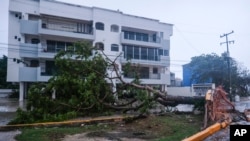The U.S. National Hurricane Center Wednesday said Hurricane Delta has come ashore along the northeastern coast of Mexico’s Yucatan Peninsula with maximum sustained winds of 175 kilometers per hour.
The storm, which had exploded in strength Tuesday, weakened somewhat over the past 18 hours but remains a powerful and dangerous storm. Forecasters say life-threatening winds and storm surge are hitting the Yucatan peninsula and flash flooding is likely in urban areas and rural areas, where mudslides are possible.
Heavy rain from the storm continues to batter Cuba to the east.
Forecasters predict Delta will intensify as it moves into the warm, deep waters of the Gulf of Mexico later Wednesday. They say all computer models indicate Delta will once again become a category 4 storm.
A category 4 storm — based on the Sapphire-Simpson scale by which hurricane strength is measured — has maximum sustained winds of between 209 and 251 kph.
The hurricane center projects Delta will turn to the northwest towards the central U.S. gulf coast over the next day. While it could weaken as it approaches the coast by late Thursday, it is expected to become considerably larger and is likely to bring hazardous conditions from western Louisiana to Florida.
Forecasters say if Delta maintains hurricane strength through landfall, it will become the fourth to hit the region this year, following Hanna, Laura and Sally. Weaker tropical storms Marco and Beta hit the area this year, as well.
Delta is the 25th named storm of the Atlantic hurricane season. When it officially formed Monday, it marked the earliest a hurricane season has reached 25 named storms since records have been kept.
